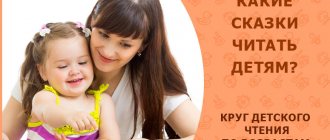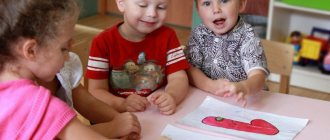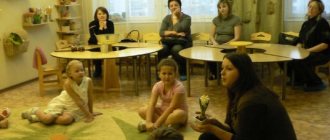Organization of reading fiction in kindergarten
Consultation for educators.
"Organization of reading fiction." Author: Oksana Evgenievna Bashkirova Position and place of work: teacher of the Mtsensk preschool educational institution “Kindergarten No. 10”.
Consultation for educators.
"Organization of reading fiction." Description: the material will be of interest to educators and parents. Goal: training teachers to correctly read fiction. When working with a book, the following tasks are distinguished: - select specific literary texts based on their developmental potential and in accordance with the characteristics of children, so that children in the book see a source of satisfaction of their curiosity and interest in the environment, feel the beauty and expressiveness of the artistic word; – provide time and environment for daily reading and relaxed discussion of literary texts; cultivate in children the habit of concentrated listening to a book; – turn to literary texts when developing other forms of joint activity between an adult and a child, using texts as a semantic background and stimulus for productive, cognitive and research activities, games, drawing analogies between the events occurring with the characters, their experiences, reasoning, reflections and their own activities child. – The realization of the developmental potential of fiction depends both on the selection of texts and on the correct organization of reading as a joint partnership activity between an adult and children. In this regard, it seems appropriate to define some methodological requirements. – Reading fiction should be daily. – The time for reading (always the same) should be determined in the daily routine. The reading duration is 10 minutes in the 2nd junior group, 10-15 minutes in the middle group, 15-20 minutes in the senior group and 20-25 minutes in the preparatory group. – Reading should take place in a relaxed atmosphere, each child voluntarily joins the readers, this is not his responsibility. Those who do not want to listen to the reading at the moment must follow the rule: do things quietly and do not disturb others. – When reading a book, the teacher acts as a partner for the children in perceiving its content; Monotonous, mechanical reading can discourage children from listening to even the most interesting book. – The teacher himself selects literary texts suitable for the children of his group, determines the sequence of their reading, guided by the principle of alternation: large literary forms for long reading - small literary forms for short reading; It is also advisable to alternate poetic and prose works. Depending on the interest and wishes of the children, you can return to previously read texts. – Large works of fiction should be read for several days in a row, since children should be able to “hold” the sequence of plot events and “get used to” the imaginary world of the book. All this becomes difficult if texts overlap each other or the same text is read with a long break. Every month the teacher reads 1-2 large works to the children. – In the period between reading two large literary texts, short works are used. These are folklore and original fairy tales, realistic stories. Here, combinations of several texts by genre or thematic focus are possible. – The teacher should not strive for a mandatory discussion with the children of the literary text immediately after reading. Discussions should be casual. They are appropriate after reading if children have questions and judgments about what they read, if the teacher intends to use the text as a semantic background, a stimulus for the activity immediately following reading, or sees the need to compare conflicts in the text with real events. After some time, the teacher can recall the texts read with the children and discuss them when developing other types of activities, since turning to the book helps stimulate the children’s activity - to comprehend and clarify any facts or events. – The teacher can find literary texts for long-term reading and their sequence 2-3 months in advance, making a balanced choice from different sections of the recommendation list, taking into account the interests of the majority of the children in the group. This preliminary plan is adjusted as necessary. – Short works are selected for a week or a month, also covering different sections of the recommendation list. In addition, when selecting and planning the sequence of reading short texts, the teacher is guided by current events, thematic cycles planned for cognitive and research activities, and the direction of the current interests of the children in the group. The list of selected texts is constantly adjusted by teachers, taking into account children’s questions that arise in a group of conflicts and collisions, the solution of which can be suggested by the book. – Each group should have several collections of literary texts from the recommendation list, from which the teacher, reacting to the current situation, can select a suitable work at any time. Additionally, a teacher can use a reader for preschool children, but it should not be the only or main source of literary texts. – It is advisable to store books for long-term reading in the general library of the kindergarten so that all groups can use them as needed.
We recommend watching:
Organization of play activities in a mixed-age group Walks and observations during the summer in kindergarten Organization of play activities in a mixed-age group Parental competence
Similar articles:
Environmental education in kindergarten
Active consultation for preschool teachers. Sensory education for preschoolers
Consultation for educators “Use of ICT in working with parents”
Learning English at a preschool educational institution
Methods of teaching modeling to young children in kindergarten
Article “Introducing preschoolers to different genres of literature”
Children express their attitude towards a literary work and its characters: in drawing, appliqué, modeling, when retelling and reciting the text, in various types of theatrical activities.
In the older group
children get acquainted with various works of Russian and foreign children's folklore: small forms (jokes, chants, riddles, fables), proverbs, sayings, fairy tales (magic, everyday, boring), epics. Children get acquainted with classical and modern poetic works (lyrical, humorous poems, poetic tales, literary riddles, fables) and prose texts (fairy tales, tales, stories). Works of art become more complex in their semantic load. Stories and fairy tales with moral overtones predominate. The language of works becomes more complex, it is distinguished by greater imagery and expressiveness, texts with descriptions and elements of popular science style (fragments of children's encyclopedias) become available.
Children understand that the content of literary works is the author’s depiction of different life situations, in the center of which is a person and his attitude to the environment.
Children begin to develop an understanding of some of the features of such literary genres as riddles, fairy tales, short stories, poems and fables; they know the names of three or four writers and poets; some facts from their biographies, some features of their work.
Children understand that a book is the result of the activities of a writer, artist and printing house workers; explain the meaning of the illustrations in the book, know the names of two or three illustrators, and some features of their work.
They know and use different ways of expressing their attitude towards a literary work and its characters in various types of speech and artistic and creative activities.
In the preparatory group
children have a rich literary experience. The reading range includes various genres of works of Russian and foreign children's folklore, classical and modern poetic works, prose texts (stories, were, fairy tales, fairy tales, children's novels). Preschoolers are interested in works with complex subtext, ambiguous images of heroes, based on the clash of characters, the confrontation between the forces of good and evil. Texts with new cognitive information and elements of business style (children's encyclopedias) become available to them. Children love texts with continuations, including novels and stories telling about new adventures of familiar characters.
Preschoolers understand that a book is a special way of understanding the surrounding reality, human relationships and social values. At this age, children know the names of five or six writers, poets, certain facts of their biography, and some features of their work.
Work experience of a teacher “Introducing a child to books”
Gulnara Khamidullina
Work experience of a teacher “Introducing a child to books”
Introducing a child to a book
The book is a kind and wise adviser, friend and teacher. For us, teachers, these words sound like an immutable truth. And our students are just discovering the wonderful world of reading, book wonders and mysteries. Therefore, our task, first of all, is to structure the work in such a way that the book is present in various areas of the child’s , children have the opportunity to communicate with books , and can develop their literary interests.
Preschool childhood as a period in human life plays an important role in shaping what a person will become. priorities laid down in preschool age . It is necessary to pay as much attention as possible to the development of the child's . a book provides invaluable assistance in this . Through reading fiction, a child learns the past , present and future of the world, learns to analyze, and develops moral and cultural values. Modern children spend more and more time playing computer games and TV, and in order to raise a reader in a child , an adult must show an interest in the book , understand its role in a person’s life, know the books recommended for children, be able to have an interesting conversation with children and help with analysis works.
During their stay in kindergarten, children listen to and retell many fairy tales, stories, and poems. At the same time, we constantly draw attention to the book . If the teacher carefully takes the book before opening it, never bends it, but carefully turns the pages, encountering painted ones, expresses displeasure with wrinkles, then the children also become defenders of the book .
Cultivating a reverent attitude toward books begins at a young age. When decorating a book corner, we first place subject and subject pictures. We teach children to look at them and answer basic questions: who (what)
This? What is he doing? Children are happy to mark already familiar objects. We pay great attention to oral folk art. Nursery rhymes, Sunshine, little bucket...", ,Kitsonka - Murysenka...", "We lived with grandma...", "Legs, you, legs...", etc.) we use jokes, jokes, proverbs, sayings not only in the classroom, but and in everyday life. All this broadens one’s horizons, develops the ability to understand the speech of adults, and master the native language.
In our classes we teach how to correctly understand and perceive the literary word. In the book corner we place familiar literary works (fairy tales, Turnip”, “Kolobok”, “Teremok”, poems (for example, A. Barto: “I love my horse...”, “The bull is walking, swinging...”, “The mistress abandoned the bunny”) ...”, “Our Tanya...”, etc., they are brightly, colorfully designed, which attracts the attention of the children, every child can come up, look at their favorite book , talk about it with their peer.
To arouse children’s interest in books , we use toys to act out scenes from works of art, and conduct didactic games such as “What book is this from?”, “Who said that?” Children guess dialogues from familiar fairy tales, poems, and recognize books by their covers .
We teach the rules of handling books , introduce new ones: books only with clean hands, always look at them at the table, turn the pages carefully, one at a time, slowly.
In the middle group, children show more interest in books . They look at the illustrations for a long time, exchange opinions on the content of the fairy tale or story. In the book corner we place familiar fairy tales, stories about nature, animals, etc. We offer for consideration, for example, the same fairy tale, “Turnip,” but illustrated by different artists (Yu. Vasnetsov and V. Dekhterev)
.
This encourages children to express their impressions of the book , how the characters are depicted, and which illustrations they liked best.
Children of this age eagerly dramatize familiar poems and fairy tales (V, Suteeva, Under the Mushroom, Russian folk tale, The Fox and the Crane, K. Chukovsky, Doctor Aibolit, Cat's House, Fly - Tsokotukha, etc. d.) look with interest at the drawings of older preschoolers on the themes of familiar works: “Kolobok”, “Teremok”, “Fedorino’s Mountain”, etc., which are hung on the kindergarten stand, and show their attitude towards the characters.
We conduct literary quizzes for children, Find out fairy tales - riddles in verse.”
What fairy tale did you come from?”, excerpts from one author from different works, etc.). We suggest recognizing a work by its cover, naming a fairy tale by its illustration or by an excerpt read from it.
To better understand the rules for handling books , we use game techniques, for example, the arrival of Parsley, the crow Karkusha, the know-it-all bunny, which resembles these rules.
In the older group, we teach children to understand the motives of the actions of the heroes of literary works, form a conscious attitude towards them, pay attention to the language of the fairy tale, story, the author's techniques and turns, and consolidate the skills of careful use of the book . Children receive a basic understanding of how books and what great value they have for understanding the world around them.
In the book we organize thematic book exhibitions: “Poets about autumn”, “The Russian Army protects our childhood”, “Through the pages of favorite fairy tales”, “First in space”, “Our , etc. etc., we also exhibit illustrations by famous children's artists I. Bilibin, Yu. Vasnetsov, V. Lebedev, E. Rachev, E. Charushin, V. Suteev and others. We continue to introduce the creativity and works of such authors as: A.S. Pushkin, L. N. Tolstoy, I. A. Krylov, M. M. Prishvin, V. Bianki, K. I. Chukovsky, S. V. Mikhalkov, A. L. Barto, S. Marshak, etc.
During classes we conduct general conversations on the topics: “What do we know about the book” , , etc. We organize special classes dedicated to the work of individual writers, poets (for example, A. S. Pushkin and others, illustrators (for example, V. Lebedev, etc.)
.
In the preparatory group, work on developing interest and respect for the book continues . By introducing children to a work of art, we ensure that they understand the main idea, can determine the genre, and note the features of the work.
We teach children of this age to understand the motives of the heroes’ actions, the position of the authors and his attitude towards his heroes. Children gain deeper knowledge about how a book , how many people work to ensure that it reaches the reader. We conduct educational classes on the topic “How is a book ?” the book came from ,” materials from such authors as T. Shorygina, K. Nefedova, L. Sankina, G. Blinova, O. Dybina, N. Aleshina, L. Selikhova, V. Volchkova and etc. Showing illustrations, we talk about writers, artists, printing house workers who, using special machines, print books and put them in a durable dress - binding, gradually children learn words such as: cover, page, spine. After children get acquainted with the process of creating a book , they begin to understand: books must be protected - after all, this is the work of many people.
At this age, we pay special attention to the contents of the book corner. Here we place:
-books recommended by the program;
-sets of postcards related to the themes of fairy tales, literary works, cartoons;
-games for speech development: “Finish the fairy tale”, “Tell the tale”, “Recognize the hero”, “Pick up the pictures”;
-portraits of writers and poets;
- children's drawings based on their favorite works.
Sometimes we make a book out of children’s stories . We periodically organize thematic exhibitions, “Funny books”, “ Books about our country” , ,E. Charushin is a writer and artist,” etc. Children also take part in their organization. So for the exhibition, “My Favorite Book book from home . But at the same time they set conditions: everyone should know its title, author well and be able to briefly tell the content. The children happily talked about their favorite works.
Conversations with children were combined with showing illustrations, repeated reading, and organizing games - dramatizations. We often returned to previously read books - after all, as children grow older, they perceive them differently , more consciously.
Book heroes come to life in the children’s drawings and modeling (we sculpt fairy-tale characters, draw covers of favorite books , illustrations for fairy tales, make bookmarks for books, etc. ). We examine, discuss, evaluate and compare the best drawings with illustrations in books - this arouses great interest and encourages creativity.
Children really like excursions to the library (which were previously held regularly)
.
We draw your attention to the fact that there are many different interesting books that you can take home and read. As a result of the work , the children became interested in the library game.” The children fairly approached the issue of distribution of roles: the librarian became the one who could tell the content of a particular work, name the author, and offer the reader an interesting book .
Among older preschoolers, didactic games “Get to know the hero”, “Find a friend”, “Who is the author?” have become popular. book repair workshop . While working together, they recalled the contents of the books , shared impressions about the actions of the heroes, and expressed opinions about the illustrations.
I would like to say a few words about theater in the lives of children. What you see and experience in the theater creates a need to tell your friends and parents about it. Promotes the development of speech, the ability to conduct a dialogue and convey one’s impressions in a monologue form, since famous children’s works are most often staged, then there is a desire to find a book , look at it, and compare it with what he saw. An interesting form is listening to works of art from disks and cassettes. Children mentally draw events, characters, pictures of nature, that is, they correlate words with objects and phenomena of extra-linguistic reality. This promotes interest in this work, then there is a desire to look at the book , the illustrations, and maybe listen to it a second time.
Of course, at any age, it is important how the teacher conveys the work he is reading or telling. Are the timbre and tempo of the voice, facial expressions, gestures, intonation, etc. chosen correctly, since we act as partners of children in perceiving the content , therefore it is necessary to show appropriate emotions - surprise, amazement, compassion, etc. Such elements will help to better understand and to convey the meaning conveyed by the author means to show interest in the book , and monotonous reading can discourage children from listening to even the most interesting book .
Large and varied work is also carried out with parents to instill in children an interest in books . These are, first of all, recommendations on what and how to read, what literature. Offer to visit bookstores, children's book , and, if possible, enroll in the library. In the mobile folders we offer information on how to foster respect for books and teach children to keep their bookshelves in order.
The work carried out in the system produces tangible results. Children, for the most part, know and follow the rules for handling books . We hope that interest in the book will grow . After all, teaching to understand and love a book means teaching to think and feel.
For many years, children of the senior and preparatory groups of our kindergarten attend classes in the library, where they get acquainted with the works of writers and poets. This acquaintance takes place in various forms: theatrical performances, competitions, literary hours, eco-hours, game programs, etc. Getting ready for the next lesson in the library, teachers read literary works to children, talk about the content, children memorize poems, dramatize works, draw on the topic.
Bibliography
Alekseeva M. M., Yashina V. I. Methods of speech development and teaching the native language of preschoolers. – M., 1998. Alieva T. Child in the world of image // Preschool education . – 1996. – No. 2. – P. 68. Bogomovskaya M.K., Shevchenko V.V. Artistic reading and storytelling in kindergarten. – M., 1966. Wenger L. How to speed up the process of understanding a fairy tale // Preschool education . – 1991. – No. 5. – P. 45. Vygotsky L. S. Imagination and creativity in childhood. – M., 1991. Vygotsky L. S. Pedagogical psychology. – M., 1991. Grishchenko Z. A. Children’s literature. Methods for introducing children to reading . – M., 2004. Gurovich L. M. et al. The child and the book . – St. Petersburg, 1996.
Dyachenko O. M. Possibilities for the development of mental abilities of preschoolers in the process of familiarization with a fairy tale // Preschool education . – 1993. – No. 11. – P. 43.
Zenkevich T. D., Mikhailov A. M. Magic source: Theory and practice of fairy tale therapy. – St. Petersburg, 1996.
Naumchik V.N. Education of a creative personality . – Minsk, 1998.
Psychology of a preschooler. Reader / Comp. G. A. Uruntaeva. - M., 1997.
Solomennikova O. A. The joy of creativity. – M., 2005.
Subbotsky E.V. A child opens the world. – 1991.
Uruntaeva G. A. Preschool psychology. – M., 1999.
Fesyukova L. B Education with a fairy tale . – Kharkov, 1996.



